Polar integration
Today, we're going to look at integrals over regions in the plane that have circular symmetry. This leads us naturally to the topic of polar coordinates.
Illustration
Here's a very natural question: What's the volume under the graph of $f(x,y)=1-(x^2+y^2)$ and over the $xy$-plane?
Illustration 3
Here's the domain of integration, namely $x^2+y^2\leq1$, with arrows indicating how we might integrate with respect to $y$ first.
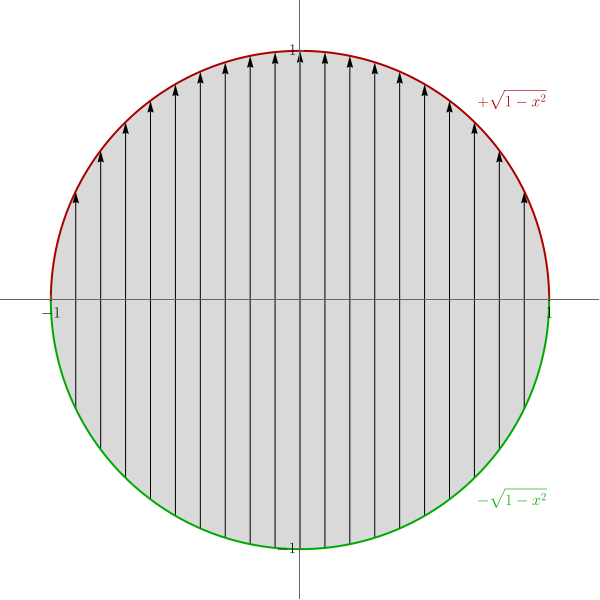
Illustration 4
Using some symmetry, this leads to the integral
$$ \begin{aligned} &4\int_0^1 \int_0^{\sqrt{1-x^2}} (1-x^2-y^2) \, dy = 4\int_0^1 \left(y-x^2y-\frac{1}{3}y^3\right)\Big|_0^{\sqrt{1-x^2}} \, dx \\ &= 4\int_0^1 \left(\sqrt{1-x^2} - x^2 \sqrt{1-x^2} -\frac{1}{3}(1-x^2)^{3/2}\right) \, dx = \color{red}{??} \end{aligned} $$Polar Coordinates
An alternative way to describe the position of points in the plane
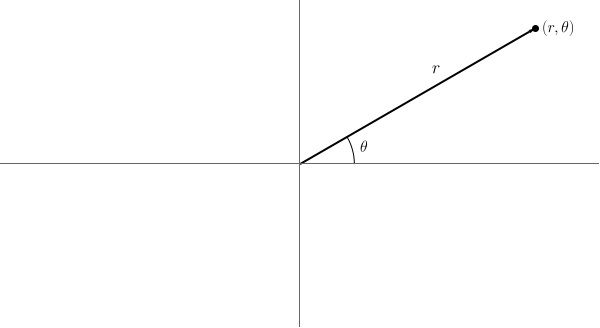
Polar coordinates 2
A few polar points with various descriptions
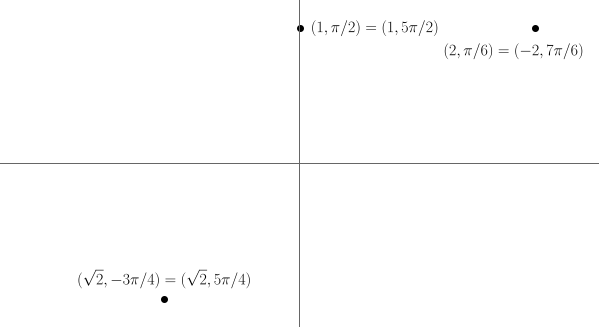
Polar coordinates 3
The relationship with $x$ and $y$
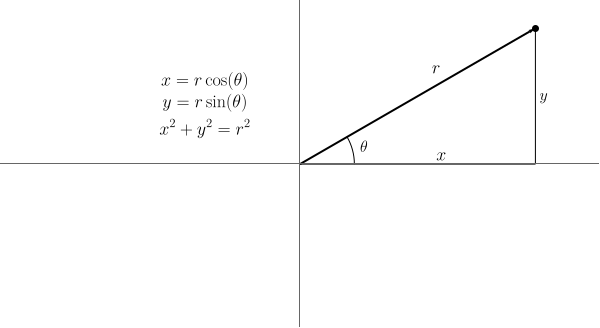
Natural regions
A rectangle is easy to describe in Cartesian coordinates because it's bound by two lines of constant $x$ and two lines of constant $y$.
Translation
There are three essential parts to translate from Cartesian to polar:
$$\color{green}{\iint_D} \color{blue}{f(x,y)} \, \color{red}{dA} \: \to \: \color{green}{\int_{\alpha}^{\beta} \int_a^b} \color{blue}{F(r,\theta)} \: \color{red}{r \, dr \, d\theta}.$$- The bounds $\displaystyle \iint_D \to \int_{\alpha}^{\beta} \int_a^b$
- The function $f(x,y) \to F(r,\theta)$
- The area element $dA \to r\,dr\,d\theta$
Translation 2
The bounds of integration typically look like $\displaystyle \int_{\alpha}^{\beta} \int_a^b$.
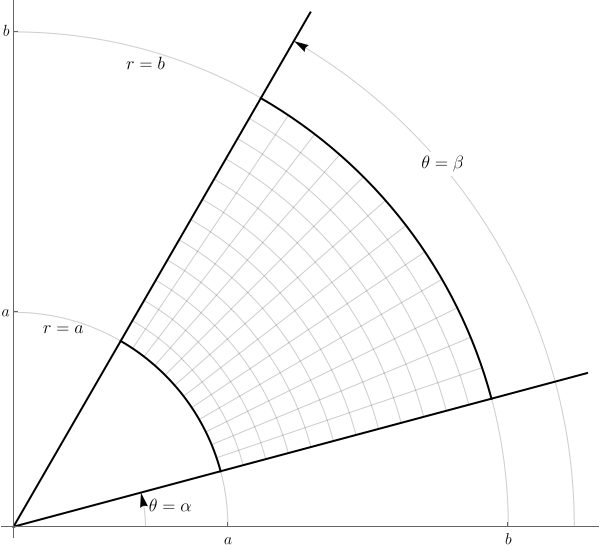
Translation 3
In this case of the whole unit disk, this boils down to $\displaystyle \int_{0}^{2\pi} \int_0^1$.
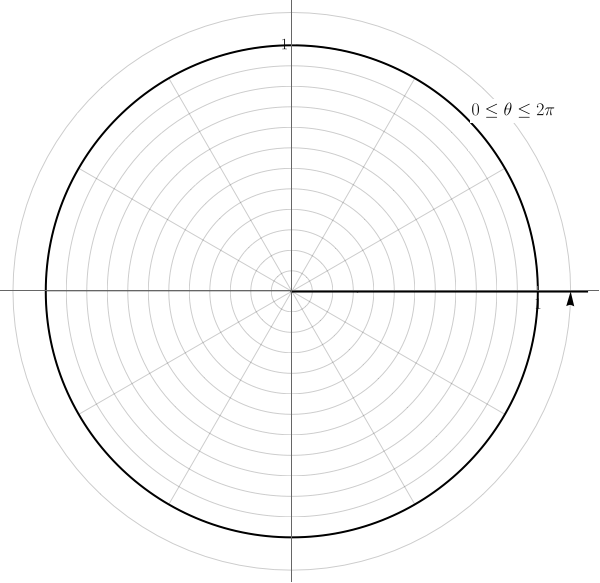
Translation 4
To translate $f(x,y)$ to $F(r,\theta)$, we can replace
- $x=r\cos(\theta)$
- $y=r\sin(\theta)$
For example, $f(x,y)=x-y^3$ would become $F(r,\theta)=r\cos(\theta)-r^3\sin^3(\theta)$.
Translation 5
Often though, we'll see an $x^2+y^2$ and we can replace that directly with $r^2$.
For example, $f(x,y)=(x^2+y^2)\sin(x^2+y^2)$, then
$$F(r,\theta) = r^2\sin(r^2).$$The result is independent of $\theta$.
Translation 6
The final step is the easiest, though slightly tricky conceptually. The $dA$ is always replaced by $r\,dr\,d\theta$. That is
$$dA \to r\,dr\,d\theta.$$To understand where the extra $r$ comes from, you need to understand that the volume represented by a polar integral is approximated by a sum:
$$\iint_d f(x,y) \, dA \approx \sum_{i=1}^m \sum_{j=1}^n f(r_i \cos(\theta_j),r_i \sin(\theta_j)) \Delta A_{i,j}.$$Translation 7
In that sum that approximates the volume, the $\Delta A_{i,j}$ term is not constant but depends on how far we are away from the origin, as illustrated in the figure.
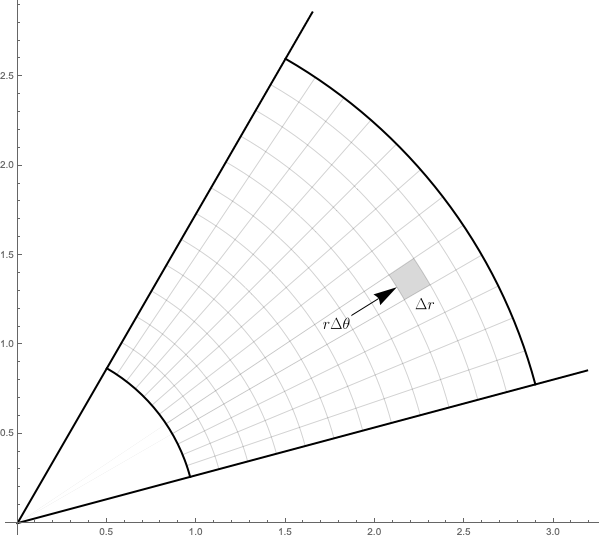
Basic example
As an example, let's return to our basic natural question: What's the volume under the graph of $f(x,y)=1-(x^2+y^2)$ and over the $xy$-plane?
Since the domain where $f(x,y)>0$ is exactly the unit disk $D$, I guess the answer should be
$$\iint_D (1-(x^2+y^2)) \, dA.$$We've just got to express that in polar coordinates.
Basic example 2
Let's translate. Our new function (expressed in polar coordinates) is
$$F(r,\theta) = 1-r^2.$$Our bounds of integration (since we're integrating over the unit disk) are $0<r<1$ and $0<\theta<2\pi$.
Thus, our new integral is
$$\iint_D (1-(x^2+y^2)) \, dA = \int_0^{2\pi} \int_0^1 (1-r^2)\,r\,dr\,d\theta.$$Basic example 3
Once we've expressed our integral in polar coordinates, it turns out to be very easy to integrate.
$$\begin{align} \int_0^{2\pi} \int_0^1 (1-r^2)\,r\,dr\,d\theta &= 2\pi \int_0^1 (r-r^3) dr \\ &=2\pi\left(\frac{1}{2}r^2 - \frac{1}{4}r^4\right)\Big|_0^1 = \frac{\pi}{2}. \end{align}$$Another example
This is very much like example 13.3.1 from our textbook. Our mission is find the signed volume between the graph of $f(x,y)=1-(2x+y)$ and over the top half of the disk of radius 2. In the image shown below, note that the graph lies partly above and partly below the $xy$-plane. By "signed" volume, we mean the volume of the portion above minus the volume of the portion below.

Another example 2
The region we are integrating over can be described as
$$\{(r,\theta): 0\leq r \leq 2, 0\leq \theta \leq \pi\}.$$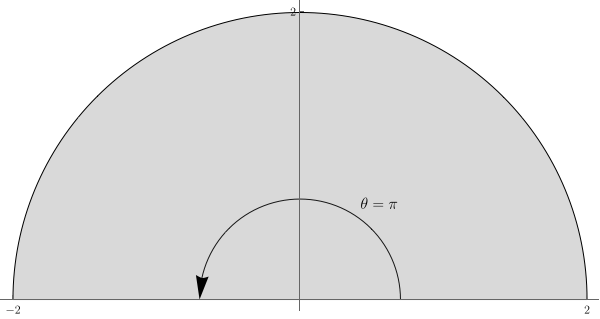
These inequalities yield our bounds of integration.
Another example 3
Our integral now becomes
$$\begin{align} \iint_D (1-(2x+y))\,dA &= \int_0^{\pi} \int_0^2 (1-2r\cos(\theta)-r\sin(\theta)) \,r \,dr \, d\theta \\ &= \int_0^{\pi}\left(\frac{1}{2}r^2-\frac{2}{3}r^3\cos(\theta)-\frac{1}{3}r^3\sin(\theta)\right)\Big|_0^2 \, d\theta \\ &= \int_0^{\pi}\left(2-\frac{16}{3}\cos(\theta)-\frac{8}{3}\sin(\theta)\right) d\theta \\ &= 2\pi - \frac{16}{3}. \end{align}$$Final example
For our final example, we're going to prove the fabulous fact that
$$\int_{-\infty}^{\infty} e^{-x^2} dx = \sqrt{\pi}.$$We'll accomplish this by evaluating an associated double integral over the plane using polar coordinates.
Final example 2
As a first step, we'll express the square of our integral as an integral over the whole plane where the integrand has rotational symmetry. I guess we want to show that this is equal to $\pi$.
$$\begin{align} \left(\int_{-\infty}^{\infty} e^{-x^2} dx\right)^2 &= \left(\int_{-\infty}^{\infty} e^{-x^2} dx\right) \left(\int_{-\infty}^{\infty} e^{-\color{red}x^2} d\color{red}x\right) \\ &= \left(\int_{-\infty}^{\infty} e^{-x^2} dx\right) \left(\int_{-\infty}^{\infty} e^{-\color{red}y^2} d\color{red}y\right) \\ &=\int_{-\infty}^{\infty}\int_{-\infty}^{\infty}e^{-(x^2+y^2)}dx\,dy \stackrel{\color{gray}?}{=} \pi \end{align}$$Final example 3
The integral we are interested in is well approximated by the integral over a disk of radius $R$, where $R$ is very large. We get the exact value by letting $R\to\infty$. Also, the extra $r$ from the $r\,dr\,d\theta$ helps us because it allows us to use the substitution $u=-r^2$.
$$\begin{align} \int_{-\infty}^{\infty}\int_{-\infty}^{\infty}e^{-(x^2+y^2)}dx\,dy &\approx \int_0^{2\pi} \int_0^R e^{-r^2}r\,dr\,d\theta \\ &=2\pi \int_0^{-R^2} e^u \left(-\frac{1}{2}\right) \, du \\ &= -\pi\left(e^{-R^2}-e^0\right) \to \pi \\ & \text{as }R\to\infty. \end{align}$$